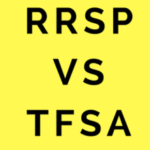 By Micheal Davis, H&R Block Canada
By Micheal Davis, H&R Block Canada
Special to the Financial Independence Hub
The registered retirement savings plan (RRSP) contribution deadline is today!
Many Canadians may be making last-minute contributions before the deadline of midnight March 2nd in hopes of unlocking a bigger tax return [if investing online; if at a physical branch, you need to act during business hours — editor.]
In fact, a recent survey from H&R Block reveals that 32 per cent of Canadians plan to contribute to an RRSP this year, a six per cent increase from last year where only 26 per cent of Canadians reported their intentions to contribute.
While RRSPs can offer tax advantages to help you reach your savings goals, it’s also important to note that they aren’t the only option available.
RRSPs vs. TFSAs
While RRSPs – a tax-deferred retirement savings vehicle in which contributions are tax deductible – can be a great investment, you do have to pay income taxes when you withdraw money, which makes this option a bit less flexible should a sudden need to access your funds arise.
Another investment tool to consider is the tax-free savings account (TFSA). Because TFSA contributions are made from after-tax income, the TFSA is a simpler tool in that it allows your investments to grow tax-free. And, since taking money out of it has no tax consequences, it can be much more flexible.
How to decide between these two investment options
The main differences between the RRSP and TFSA are their contribution limits, withdrawal restrictions, and how and when you pay taxes. Both are investment vehicles that can shelter taxes on your investments, but depending on your circumstances, one might suit you better than the other.
Contribution Limits
Both an RRSP and TFSA have contribution limits, which can impact how much money you’re able to allocate to each. When thinking about where to invest your money, keep in mind that the maximum RRSP contribution for 2019 is 18 per cent of your earned income or $26,500, whichever is lower plus any contribution room carried forward from previous years. Any unused contribution room can be carried forward to the next year. On the other hand, the TFSA contribution limit for 2020 is $6,000, flat from 2019. Because it’s also cumulative, if you have never contributed and have been eligible for the TFSA since it was first introduced in 2009, the limit is $69,500.
Withdrawal restrictions
When you contribute to an RRSP, it is very difficult to withdraw any money without incurring a tax penalty. The opposite is true with TFSAs. You can make tax-free withdrawals from a TFSA at any time, which is both good and bad: it’s useful in times of emergency, but it can be tempting to turn to it when you need money. However, if you do make a withdrawal from your TFSA, the amount is added back to your contribution room for the following year.
How and when you pay taxes
RRSP contributions are done with pre-tax income, which means you’ll essentially get to deduct those contributions from your total income. This can result in a tax refund based on the amount of income tax you paid that year. On the other hand, your contributions to a TFSA are made from after-tax income and are not deductible for income tax purposes.
Both RRSPs and TFSAs are worthwhile investment options, and you don’t have to pick one exclusively over the other. You can contribute to both and the ideal situation, if you’re in the financial position to do so, is to max out your contribution every year to take full advantage of both investment vehicles. But if that’s not within reach, there are still ways you can make the TFSA and RRSP work together to improve your overall wealth.
Understanding the basics of how these investment tools work and how they can benefit you is the first step to having a strong financial foundation, especially when trying to maximize your tax return.
If you have any questions or want to learn more on how to get the most from your tax return, visit an H&R Block office near you to speak to a Tax Expert today.
 Micheal Davis is a Senior Tax Expert with H&R Block Canada, with more than four years’ experience with the company. Currently the District Operations Coordinator, he oversees the day-to-day operation of all Thunder Bay area H&R Block offices, manages the area’s H&R Block Tax Academy classes and facilitates the needs of a multi-office district. Prior to joining H&R Block, Micheal worked in financial services.
Micheal Davis is a Senior Tax Expert with H&R Block Canada, with more than four years’ experience with the company. Currently the District Operations Coordinator, he oversees the day-to-day operation of all Thunder Bay area H&R Block offices, manages the area’s H&R Block Tax Academy classes and facilitates the needs of a multi-office district. Prior to joining H&R Block, Micheal worked in financial services.



The article incorrectly indicates that you can contribute 18% of your gross income to an RRSP. It should be 18% of your earned income. This is a significant difference for anyone with sources of income other than employment or self-employment income.